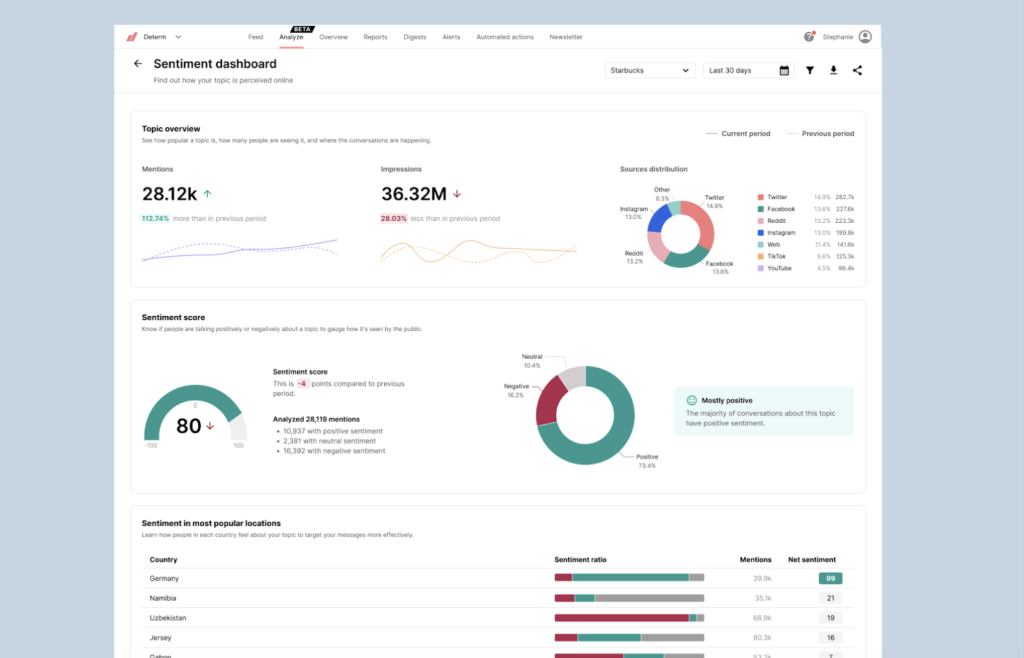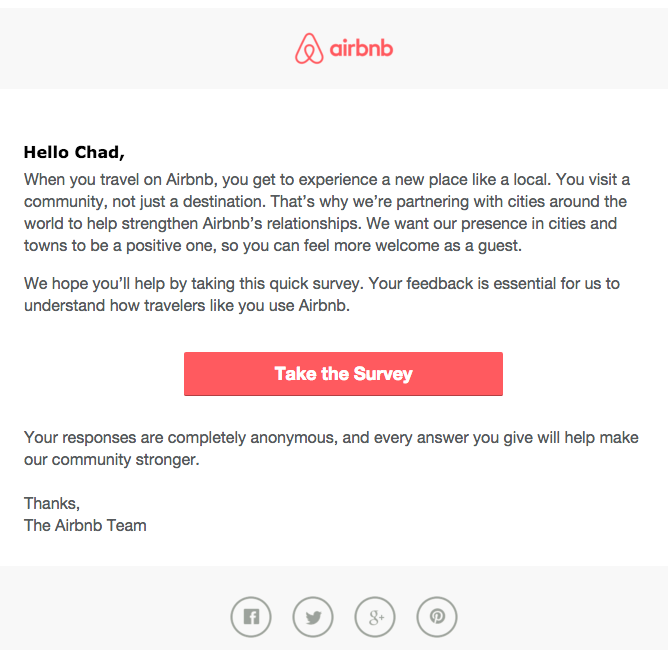Customer sentiment refers to thoughts and feelings customers have towards a company. When customers interact with your brand, the nature of their experience will influence their perception of your brand.
💡 Read Sentiment Analysis 101: Everything You Need to Know
As a business owner, it’s important that you keep track of your customer sentiment so you can improve your brand reputation and service delivery. This information can be gathered by analyzing brand mentions on online platforms like social media, forums, and blog post comments. You can also use a brand monitoring tool, making it easier to know what people say about your brand.
In this guide, we’ll share some important reasons why your business should pay attention to customer sentiment and how it can help you.
Reasons to Track Customer Sentiment
1. Helps you improve your services
Every business should assess its product or service and seek ways to improve them. You should know whether your product engages with the market or not and if it provides value to your target audience.
Customer sentiment allows you to gather market insight into your product. This insight is solid, fundamental data you can use to refine your product.
Suppose you’re a coffee shop. Imperative information could be learning that your new drink is underwhelming to consumers. Just like with Starbucks’ case, as shown above. Therefore, you may need to improve the drink if social media users are unimpressed with your new flavor. Or, do a quality check on how baristas prepare your new drink.
Apart from food and drink companies, other businesses can thrive by tracking customer sentiment. So, manufacturers, marketers, course creators, and service providers can also use customer sentiment to learn how they can improve.
Marketers may learn whether their latest campaigns resonate with the audience or not. Meanwhile, online course creators may learn whether learners found their course valuable. Also, if they had selected the right platform for their course business, and if the presentation was engaging.
With such insights, you not only know your current performance, but you also get some details on how you could improve going forward. That’s the power of tracking customer sentiment.
Read Improve Your Customer Support with Media Monitoring
Look for product mentions across social media
Create a hashtag around your product to monitor user sentiments more easily.
Use the same hashtag for Twitter, Instagram, Facebook, etc.
Use a brand monitoring tool
Tools like Determ will help you keep up with your rapidly growing customer base by providing insight into your brand mentions across online platforms.
The tool tracks all mentions of your brand (including the untagged ones) across millions of sources and gives you the opportunity to react immediately if a bad comment appears somewhere. In addition, it provides reports where you can get an overview of the mentions of your brand and see immediately if there is an increase of the negative ones, and why.

Read Sentiment Tracking: How to Get Inside Your Customers’ Minds?
Send email surveys to your most engaged customers
Assess their sentiments on your product, just as Airbnb does below. You can use 1-5 ratings or open-ended questions to achieve this. Email marketing solutions like Hubspot and Mailchimp and their alternatives have templates for customer satisfaction surveys.

You may find a lot of non-constructive, negative customer feedback from gathering these sentiments. But you’ll also find mentions containing constructive customer feedback detailing how you can improve.
After collecting customer sentiments, share the information with your product development team, operations manager, or other relevant departments. Then work together to address the customer issue(s) and improve customer sentiments.
2. Aids in brand monitoring
Brand monitoring is the process of analyzing where and how your brand is mentioned across the web, e.g., on Reddit forums, YouTube comments, etc. Knowing where your brand is mentioned and what people say about it will help you manage your brand’s reputation.
Emotion is a factor in consumers’ purchasing decisions. So a tarnished brand reputation may mean a dip in sales. When done correctly, brand monitoring can prevent this dip or decline from happening.
Standard brand monitoring includes addressing negative Tweets or mentions and responding to infuriated social media posts. Addressing these online statements helps to mitigate a negative reputation, just like Spectrum does below.
Read Brand Monitoring 101: Tips, Strategies & Tools
Gathering customer sentiment is the listening process of brand monitoring. By gathering customer sentiment, you monitor how people perceive your brand, its products, and in some cases, your staff’s service.
By understanding the market sentiment around your brand, you’ll be able to adjust your service delivery and make the necessary changes to improve customer sentiment and, by extension, your brand reputation.
3. Leads to better customer service
It’s not enough that you have effective marketing campaigns to acquire new customers. You must also retain your existing ones. One way to do this is through effective customer service.
Effective customer service is a must for complex products such as electronics and digital services. If you’re an ecommerce business, customer service is essential for refunds and returns. This is something to consider when you start a business. Not to mention – analyzing customer sentiment can help you deliver excellent customer service. Taking the help of virtual assistants who are experts in conducting pleasant and personal consumer interactions can help multiply business growth.
Customer sentiment can help you understand which part of your product pleases, confuses, and infuriates consumers.
Twitter serves as one of Hubspot’s channels for customer product insights, as shown below. From the tweet below, Hubspot can determine that its customers are losing patience with one of its products.
The user data you gather from social media sentiments will help you formulate better response templates to common queries. These templates will optimize the support process for customer support reps.
Hubspot was able to add a relevant resource to its knowledge base, as shown below. This information details how users can add videos to their Hubspot-created emails and blog posts.
With sentiment analysis (in this case, tuning in to Twitter), Hubspot refined its knowledge base with FAQs. This creates a better support process for reps and customers.
Here are some ways to collect detailed sentiments to support your customer service:
Gather recorded calls and customer conversations
Assess commonly-asked questions so you can create an FAQ. This can speed up ticket processing, creating faster customer service. Consumers in the queue will be pleased as a result.
You may also conduct satisfaction surveys after every customer complaint ticket. Ask consumers to rate your service after each interaction. If a customer service agent consistently receives low ratings, you may need to give them some attention.
You can add open-ended questions to your customer satisfaction survey as well. With this, unhappy customers can give more detailed feedback on their experience. Take this customer feedback into account when tweaking your customer service.
Look at Tweets that mention you too
Customers tend to rant on Twitter whenever they have a negative experience, just like the earlier Hubspot example. These rants will mention your name and their concern. Assess these Tweets just like you would with customer interactions.
Train your customer service representatives to respond on social media for better customer service—Twitter, especially.
You provide a positive brand experience by refining your customer service. This will improve brand affinity and loyalty.
Read How to Do Twitter Sentiment Analysis Without Breaking a Sweat?
4. Helps in tracking sentiment over time
Over time, your business model may change. You may change your pricing structure or reform your customer service policy. Global culture changes rapidly as well. It can be challenging to keep a positive reputation with these shifting variables.
Track customer sentiment to assess your brand’s reputation over time. You can be a household name one year; a negative connotation the next. That’s why you must monitor the sentiments of your customers consistently.
For example, BMW is one of the most popular automakers in the world. However, its recent heated seat subscription policy was met with hot criticism, as shown in the Tweet below. This and other discussions around the topic would have been enough for the company to go back and really decide whether to move on with the policy or not.
You can choose to retract the change in policy and user features if it’s met with backlash. Or, you may roll with the change and convince your users why it’s a good thing. Whichever route you go with, tracking sentiment allows you to make a more informed decision on the matter.
5. Improves your marketing campaigns
Advertising platforms already give you valuable data. You can see metrics such as reach, engagement, and cost-per-conversion on these platforms. However, these numeric data are incomplete without customer sentiment analysis. Numbers can only say so much.
According to growth marketer Zach Grove, tracking customer sentiment can also help you unlock valuable customer stories.
“Once you have a segment of customers who love your product, I recommend sending these ‘super fans’ a short, testimonial-gathering email. Link out to a quick survey—or simply ask folks to reply with a testimonial if they’re willing. This one email will give you a gold mine of social proof to use in your ads, landing pages, emails, and more.”

Analyzing customer sentiment tells you why the numbers are the way they are. That allows you to adjust your marketing campaigns accordingly.
Customer sentiment also serves as the listening process. Your marketing campaigns are how you “talk” with your audience. So, suppose your audience perceives you as an impractical, expensive brand. You may adjust your marketing campaigns to accommodate a more premium branding.
From this listening process, you will also understand where your audience lies.
Improved marketing campaigns maximize your marketing budget. You get better-engaging ads for a fraction of what ineffective ads cost you.
Read How to Secure your Marketing Campaign’s Success
Conclusion
Customer sentiment is one reliable way to determine which area of your business to improve. With the deep insight of your existing patrons, you can refine your brand experience, customer loyalty, and any other business area. Tracking your customer sentiment helps you improve your services, aids in brand monitoring, helps you provide better customer service, and improves your marketing campaigns.
Now that you know why tracking customer sentiment is essential, you can go ahead to implement it and provide a better customer experience.
Baidhurya Mani is the founder of SellCoursesOnline.com. He regularly shares tips, tools, and strategies to help creators and entrepreneurs build a successful online course business.